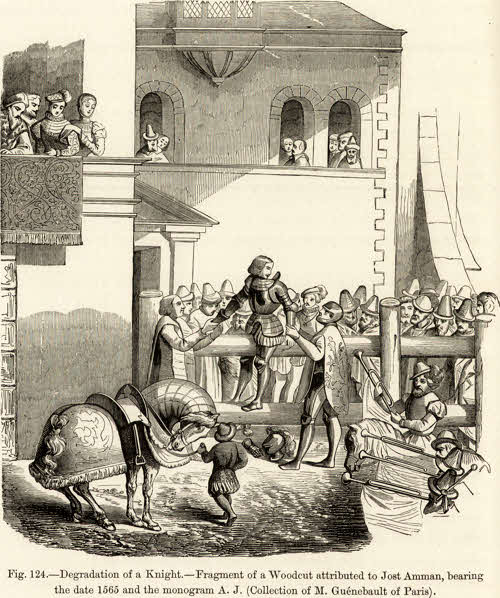Thus, even in the splendor of those days, the sun had its spots and the ermine was not always clean; and for all that no unbaptized man might be a knight, here and there was one no better than a heathen. When the infamy of such a one became too notorious and his recreancy had stretched out to shame, he was publicly degraded. Armed by his brother knights as if going to battle, he was taken to the church where the king and all his court were assembled.
 There he was unharnesssed, piece by piece; and as each piece was flung with a ringing clang on the floor the herald shouted out, “Behold the harness of a disloyal and recreant knight.” His sword was broken over his head, and his spurs were hacked off by a base-born churl. A silver basin of hot water was brought and his name was asked. When given, the king-at-arms said, “That is not true, for he is a recreant and false traitor and hath transgressed the ordinances of knighthood.” The priest returned, “Let us give him his right name”; on which the warm water was splashed in his face, and with this dishonorable baptism he was newly named—“Traitor.” He was then laid in his grave and the funeral service was read over him—the king and all his court in mourning garments as for a dead brother-at-arms and loyal knight. When he came again to life and the light of heaven, he was a ruined man—banished, degraded, made infamous for ever.
There he was unharnesssed, piece by piece; and as each piece was flung with a ringing clang on the floor the herald shouted out, “Behold the harness of a disloyal and recreant knight.” His sword was broken over his head, and his spurs were hacked off by a base-born churl. A silver basin of hot water was brought and his name was asked. When given, the king-at-arms said, “That is not true, for he is a recreant and false traitor and hath transgressed the ordinances of knighthood.” The priest returned, “Let us give him his right name”; on which the warm water was splashed in his face, and with this dishonorable baptism he was newly named—“Traitor.” He was then laid in his grave and the funeral service was read over him—the king and all his court in mourning garments as for a dead brother-at-arms and loyal knight. When he came again to life and the light of heaven, he was a ruined man—banished, degraded, made infamous for ever.
E. Lynn Linton, “The Women of Chivalry,” in Frank Harris, ed. The Fortnightly Review (London: Chapman and Hall, Ltd., 1887), (Jul. 1–Dec. 1, 1887), 42:562–3.









